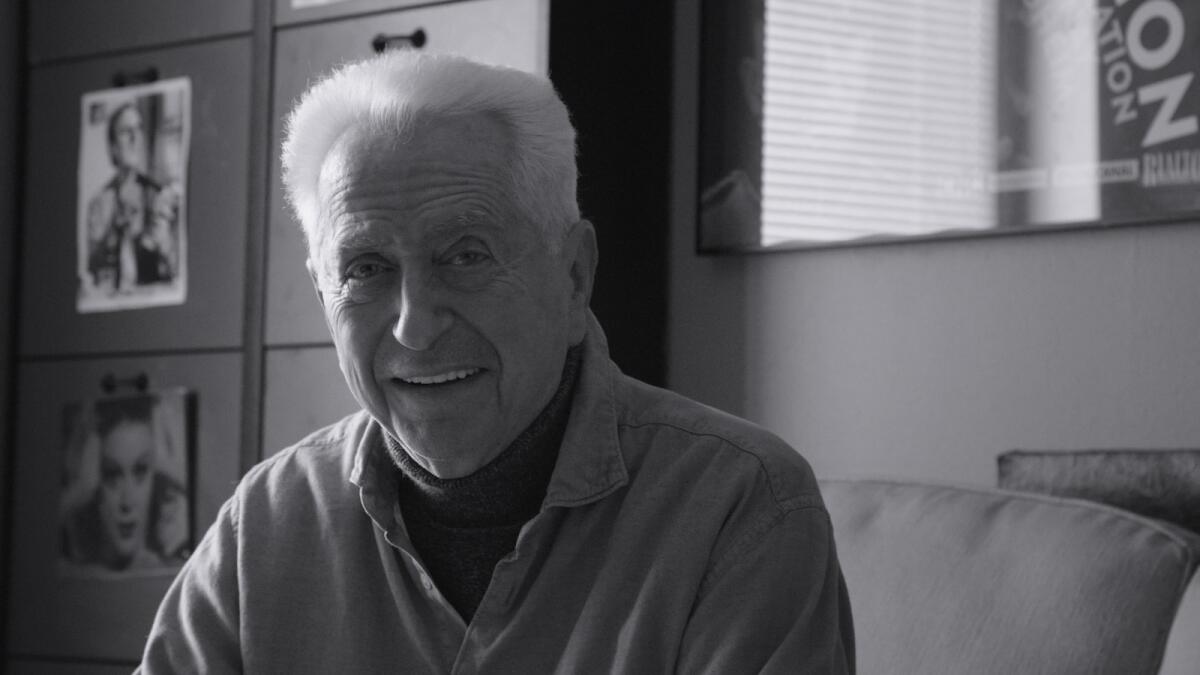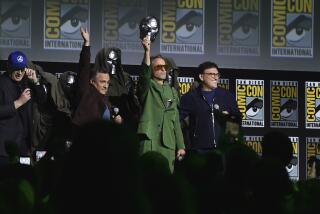Review: ‘Sr.’ pairs the Robert Downeys in tender tribute to avant-garde filmmaker

- Share via
Like father, like son? It’s a question that’s answered in affecting, if not always thoroughly probing ways in the otherwise compelling documentary “Sr.,” a lively look at cult filmmaker Robert Downey Sr. and his exponentially more famous, deeply devoted son: “Iron Man,” “Avengers” and “Sherlock Holmes” star, Robert Downey Jr.
Downey Sr. (born Robert Elias and referred to here simply as “Sr.”) may have been little more than a blip on the cinematic radar these last few decades. But in the late 1960s, he became a counterculture icon after making such absurdist underground movies as “Chafed Elbows,” “No More Excuses” and his most notable and influential hit, the anarchic ad-agency satire “Putney Swope.” His well-timed work was a barbed, unapologetic mirror of that era’s political and social turbulence.
For your safety
The Times is committed to reviewing theatrical film releases during the COVID-19 pandemic. Because moviegoing carries risks during this time, we remind readers to follow health and safety guidelines as outlined by the CDC and local health officials.
Unfortunately, follow-up films such as 1970’s humans-playing-animals comedy “Pound” and 1972’s acid western-Christ parable, “Greaser’s Palace,” did little to burnish his reputation. He went on to have a kind of herky-jerky helming career until exiting the film scene in 2005 with the Philadelphia-set documentary, “Rittenhouse Square.”
But it’s Downey Sr. the unconventional family man, as much as the subversive filmmaker, who gets his close-up here, as father and son share time on camera (in person and via COVID-necessitated Zoom and phone calls) from 2019 until Sr.’s death in mid-2021 of complications from Parkinson’s disease. They chat about life and their many shared experiences, including Downey Jr.’s formative gigs as a kid actor in “Pound” and “Greaser’s” and their later collaborations on Downey Sr.’s obscure comedies “Too Much Sun” (1990) and “Hugo Pool” (1997). (1987’s porn-industry satire, “Rented Lips,” goes unmentioned, perhaps for good reason.)
What most notoriously binds Sr. and son, however, was a long and self-destructive addiction to drugs: Downey Sr.’s began in the mid-‘70s; Jr.’s far more well-documented habit landed him a prison stretch a few decades later. The doc touches upon, rather than dissects, the idea that Jr.’s addiction may have been inadvertently fostered by his permissive dad, a seemingly pivotal piece of their symbiotic dynamic.
In addition, where exactly was Downey Sr. — not to mention Downey Jr.’s actress-mother and Downey Sr.’s first wife, Elsie (they divorced in 1982) — during Downey Jr.’s darkest days? Just a bit of referencing might have helped round out some patchy family history. (Downey Sr. and Elsie’s second child, Allyson, is only fleetingly mentioned and shown.)
But this is mostly a buoyant and affectionate portrait, one that enjoyably showcases Downey Sr.’s sweet irascibility (and undeniable charm), Jr.’s offhand jauntiness and the puckish duo’s mutual love of film, family and irreverence. That is its strength and, it seems, raison d’être, even if the film, directed by Chris Smith (“American Movie,” “Fyre”), with what might be called an unofficial assist from Downey Sr., feels largely made up as they went along — and a product of some skillfully managed editing. (Clearly still a director in his bones, the elder Downey also worked on a kind of shadow version of a bio-doc, bits of which are seen here.)
Shot in New York, L.A. and East Hampton in atmospheric black-and-white (effectively recalling the vibe of Sr.’s early output), the movie features an array of clips from most of Downey Sr.’s films, including 1975’s alliteratively titled — and narratively incomprehensible — “Two Tons of Turquoise to Taos Tonight” and the iconoclast’s one ill-fated (and admittedly terrible) foray into studio directing, the 1980 military-school farce, “Up the Academy.”
Snippets of Sr.’s acting stints in a few of his early works as well as a role in Paul Thomas Anderson’s “Boogie Nights” are also woven in, as are interviews with friends including Anderson (who provides personal archival footage), Alan Arkin, Norman Lear and Lawrence Wolf, the last a frequent performer in Downey Sr.’s ’60s and ’70s films.
Additional archival clips of Elsie Downey (a game mainstay in many of Downey Sr.’s films; she died in 2014) and Sr.’s second wife, actress-writer Laura Ernst, who died in 1994 at age 36 of ALS, are featured as well. We also meet Sr.’s third wife, Rosemary; Downey Jr.’s second wife and business partner, Susan (a producer here with Downey Jr.); and Jr. and Susan’s young children, son Exton and, more briefly, daughter Avri.
The good-natured Exton plays a key part toward the end of the doc when he and his dad visit New York to spend some final time with the dying Downey Sr. These concluding moments among three generations of Downey men are lovely and memorable.
“Sr.” proves a tender portrait and fitting tribute to an offbeat hero and creative pioneer.
'Sr.'
Rated: R, for language and some drug use
Running time: 1 hour, 29 minutes
Playing: Starts Nov. 23, Laemmle Monica Film Center, Santa Monica; available Dec. 2 on Netflix
More to Read
Only good movies
Get the Indie Focus newsletter, Mark Olsen's weekly guide to the world of cinema.
You may occasionally receive promotional content from the Los Angeles Times.










